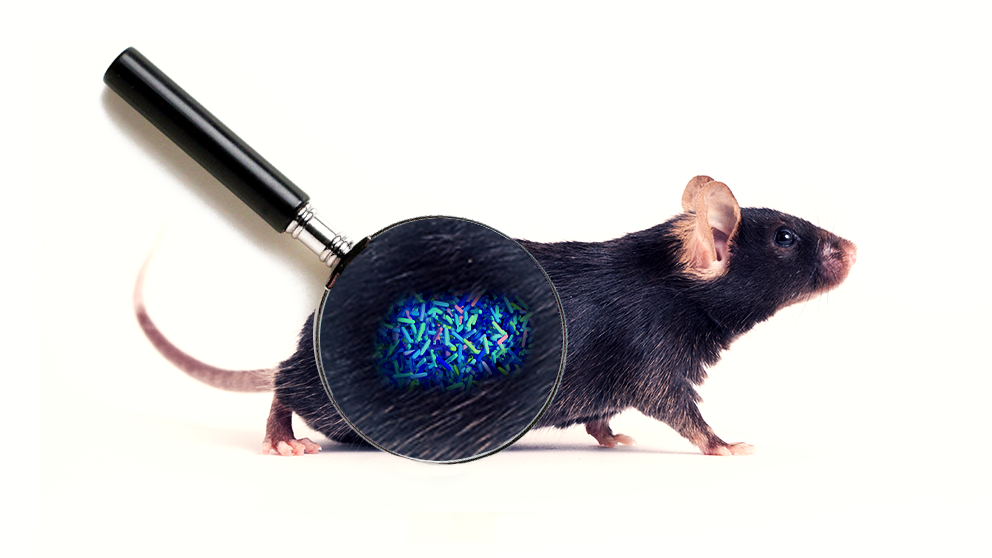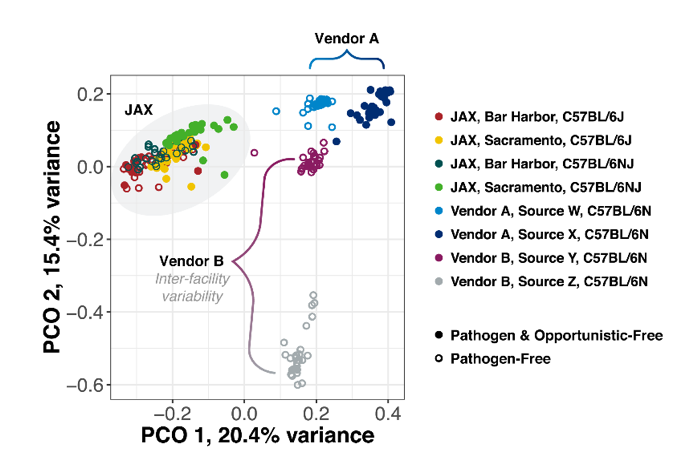
|
Why it Matters Where Your Mice Come From
If you are starting a new study, you might become overwhelmed with the decisions you need to make. One decision is mouse strain selection, particularly if you can acquire similar strains from several sources whether this is from different vendors, a local core facility, or a collaborator.
With regards to the microbiome, it has been reported that the microbial communities of mice from different vendors vary widely and may impact experimental conclusions. For example, one study reported large differences in the abundance of Th17 immune cells, a population that is important for inflammatory responses in the small intestine, and that these cells could be influenced by gut microbial populations (Ivanov 2008 Cell Host Microbe, PMID 18854238). C57BL/6 strains from several academic sources and commercial vendors such as Taconic were observed to have a relatively high proportion of Th17 cells while mice from The Jackson Laboratory (JAX) had very few Th17 cells present. It was later determined that segmented filamentous bacteria (SFB) in the gut could induce Th17 cell development and that this development was impaired in mice lacking SFB (Ivanov 2009 Cell PMID 19836068).
Microbiome variation in mice from different institutions is not surprising, given that each institution will differ in food, water, and bedding sources; in facility design; and in operational practices, including health monitoring. In addition to the aforementioned mouse-extrinsic factors, microbial signatures may be affected by mouse-intrinsic factors: the exact genetics of even similarly named mouse substrains will differ from each vendor as a result of the natural phenomenon of genetic drift.
How does the JAX Gut Microbiome Compare to other Vendors?
Whether microbiome differences will impact your research depends on your scientific question. Unfortunately, it is extremely difficult to predict ahead of time which microbes will or will not affect your research. However, if you can source animals from a vendor that provides mice with a consistent microbiome, you will have a better chance of producing experimental results with lasting, reproducible impact.
In a previous study, we reported that the microbiomes of 3 commonly used JAX mouse strains were stable over a 5-month period and that each mouse strain was associated with a distinct microbial signature.
Observations from this study prompted us to develop a companion study, in which we queried how the gut microbiomes of JAX mice compared to the gut microbiomes of similar substrains of mice from 2 other major commercial sources. We found at intake into a distal academic research facility, C57BL/6 mice from different locations at JAX were more similar to each other than C57BL/6 mice sourced from other commercial vendors from different locations.
Study Design for Gut Microbiome of C57BL/6 Mouse Substrains
C57BL/6N mice from JAX (C57BL/6NJ, Stock 005304) and two additional commercial vendors were shipped to an academic animal research facility specializing in microbiome research. Fresh catch stool samples were collected from male and female mice at intake, and sequencing of the 16S rRNA V1V3 region was performed to compare microbial compositions. Samples of C57BL/6J mice from JAX (Stock 000664) were also included in our analysis as a reference to assess substrain differences in bacterial community structure.
Male and female mice from each vendor originated from 2 geographically distinct facilities. “Pathogen & Opportunistic-Free” and “Pathogen-Free” rooms from each vendor were assessed across most of the tested groups. Pathogens are organisms known to cause disease or compromise animal health; opportunistic organisms are not pathogenic in healthy, immunocompetent mice, but may cause infections in health-compromised or immunodeficient mice. Each vendor varied in the exact collection of pathogens or opportunists that they monitor ( See JAX’s list of agents monitored).
Gut Microbiomes of JAX C57BL/6 Substrains are More Similar to Each Other than Other Vendors Across Locations and Health Status
As has been published previously, mice from different vendors exhibited distinct microbial profiles at intake. However, JAX mice were observed to display a more similar microbiome when compared to mice from other vendors. Indeed, when visualized by Principle Coordinate Analysis, JAX mice cluster tightly together regardless of facility location or health status. Interestingly, the consistency of JAX microbiomes also held true when comparing C57BL/6NJ to C57BL/6J mice, two distinct C57BL/6 substrains, which have been genetically separated since 1951.

In contrast, both Vendor A and Vendor B showed significant microbiome differences from one facility to the next. For Vendor A, a microbiome difference could, in part, be attributed to the differences in health status. However, for Vendor B, both facilities had identical health status classification yet showed robust microbiome differences between facilities for a single mouse strain.
Together, this suggests that JAX can maintain relatively stringent control over gut microbial variability across multiple health statuses and geographical locations and that substrain differences between C57BL/6J and C57BL/6N mice contribute less drastic changes in microbial structure than other variables such as vendor selection.
Decision Time
As a mouse provider of reliable research models, JAX has a responsibility to supply mice of consistently high health status to investigators around the world. In addition to rederiving all mouse strains that are donated to our repository, we take great care to exclude pathogens and opportunistic organisms from our mouse colonies.
Mice in both “Pathogen and Opportunistic-Free” as well as “Pathogen-Free” rooms receive all of the following key products sterilized by autoclave: feed; acidified, filtered drinking water; bedding, and microisolator (individually HEPA filtered) caging. Caging equipment is sanitized through tunnel washers before being autoclaved. Animal technicians adhere to a rigorous room entry procedure which includes full gowning with multiple forms of personal protective equipment, including face and head coverings. Technicians in “Pathogen and Opportunistic-Free” rooms don HEPA filtered air hats and finish with air shower entry.
In all rooms at JAX, health monitoring is performed every six weeks on the animals. Diagnostic testing of feed, water, housing surfaces, and equipment is completed to validate these processes and ensure the quality of our mice.
You have many decisions to make in where you source your mice. One decision you can’t compromise on is the quality of the mice you use and the reproducibility of the results you generate.
Explore the ways JAX invests in the quality of the mice produced:
References
Ivanov II., 2008. Specific microbiota direct the differentiation of IL-17-producing T-helper cells in the mucosa of the small intestine. Cell Hose Microbe. 4(4):337-49. PMID 18854238
Ivanov II., 2009. Induction of intestinal Th17 cells by segmented filamentous bacteria. Cell. 139(3):485-98. PMID 19836068